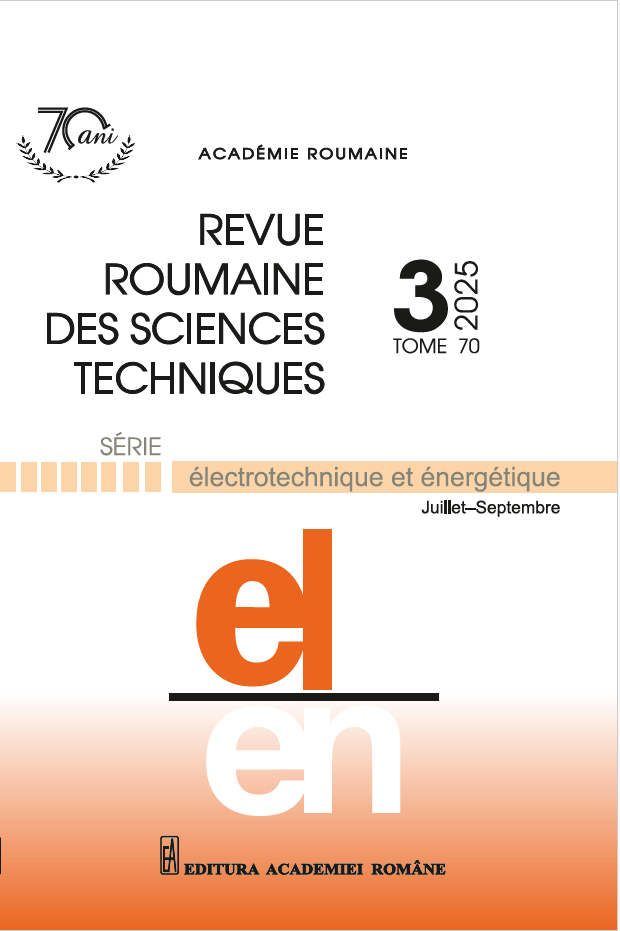USEFUL ASSUMPTION FOR SIMPLIFIED NUMERICAL ANALYSIS OF TRANSCRANIAL MAGNETIC STIMULATION
DOI:
https://doi.org/10.59277/RRST-EE.2025.3.24Keywords:
Transcranial magnetic stimulation (TMS), Inductor current, Numerical analysis, Finite element method (FEM)Abstract
Magnetic stimulation is a bioelectromagnetic effect of exposing the human body to a time-varying magnetic field; excitable tissues (nerves, muscles, sensory organs) can be activated by the electric field (or associated electric current) generated by electromagnetic induction. The biological effects of stimulation have medical applications in a dynamic class of neuromodulation techniques, such as transcranial magnetic stimulation. However, hazardous human exposure to low-frequency, high-amplitude magnetic fields may also be associated with an increased incidence of health risks, as observed in specific occupational exposure scenarios. This study presents some typical issues related to the numerical simulation of electromagnetic field problems in this class (formulation, data, methods, implementation, accuracy), provides specific quantitative estimates (postprocessing of electromagnetic solutions), and illustrates the practical possibility of reducing the consumption of computational resources by adopting a simplified problem description that replaces a transient analysis with a time-harmonic analysis.
References
(1) S. Ueno, M. Sekino, Biomagnetics. Principles and Applications of Biomagnetic Stimulation and Imaging (Chapters 2 and 3 on Biomagnetic Stimulation), CRC Press, Taylor&Francis Group (2016).
(2) P.M. Rossini et al., Non-invasive electrical and magnetic stimulation of the brain, spinal cord, roots and peripheral nerves: Basic principles and procedures for routine clinical and research application, Report from an IFCN Committee, Clinical Neurophysiology, 89, 6, (2015).
(3) A.M. Morega, M. Morega, A.A. Dobre, Computational Modeling in Biomedical Engineering and Medical Physics (Chapter 7 - Magnetic stimulation therapy), Academic Press, Elsevier Inc., pp. 217-245 (2021).
(4) C.M. Ciocăzanu, N.S. Stanciu, M. Morega, An Electrical Engineering Perspective on Neuromodulation – Characteristics of the Magnetic Stimulation Procedure, U.P.B. Sci. Bull., Series C, 86, 4, pp. 349–366 (2024).
(5) A.T. Barker, R. Jalinous, I.L. Freeston, Non-Invasive Magnetic Stimulation of Human Motor Cortex, The Lancet. 325, 8437, pp. 1106–1107 (1985).
(6) C. Hovey, R. Jalinous, The Guide to Magnetic Stimulation, © The Magstim Company Ltd. (2006).
(7) ***Magstim® Inc., Pioneers in Neurotechnology. MAGSTIM TMS Catalog The Magstim® Company Ltd. (2024).
(8) Z.D. Deng, S.H. Lisanby, A.V. Peterchev, Electric field depth-focality tradeoff in transcranial magnetic stimulation: Simulation comparison of 50 coil designs, Brain Stimul. 6, pp. 1–13 (2013).
(9) V. Guadagnin, M. Parazzini, S. Fiocchi, I. Liorni, P. Ravazzani, Deep Transcranial Magnetic Stimulation: Modeling of Different Coil Configurations, IEEE Trans. Biomed. Eng., 63, 7, pp. 1543–1550 (2016).
(10) M.I. Gutierrez, et al., Devices and Technology in Transcranial Magnetic Stimulation: A Systematic Review, Brain Sci., 12, 9, art. no. 1218 (2022).
(11) T. Kowalski, J. Silny, H. Buchner, Current density threshold for the stimulation of neurons in the motor cortex area, Bioelectromagnetics 23, 6, pp. 421–428 (2002).
(12) A. Barchanski, Simulations of Low-Frequency Electromagnetic Fields in the Human Body, PhD Thesis, TU Darmstadt (2007).
(13) S. Ueno, New Horizons in Electromagnetics in Medicine and Biology, Radio Science, 56, 4, 17 pages (2021).
(14) D. Rafiroiu, S. Vlad, L. Cret, R. Ciupa, 3D Modeling of the Induced Electric Field of Transcranial Magnetic Stimulation, IFMBE Proc., 26, pp. 333–338 (2009).
(15) N.J. Tachas, K.G. Efthimiadis, T. Samaras, The Effect of Coil Modeling on the Predicted Induced Electric Field Distribution During TMS, IEEE Transactions on Magnetics, 49, 3, pp. 1096–1100 (2013).
(16) ***IEEE Std C95.1-2019 for Safety Levels with Respect to Human Exposure to Electric, Magnetic, and Electromagnetic Fields, 0 Hz to 300 GHz, Annex B.2 Rationale for limits based on electrostimulation, Copyright © 2019 IEEE.
(17) M. Lu, S. Ueno, Computational Study Toward Deep Transcranial Magnetic Stimulation Using Coaxial Circular Coils, IEEE Transactions on Biomedical Engineering, 62, 12, pp. 2911–2919 (2015).
(18) E. Salkim, T. Abut, Human Head Transcranial Magnetic Stimulation using Finite Element Method, Kocaeli Journal of Science and Engineering, 7, 1, pp. 62–70 (2024).
(19) A. Ramaiah, P.D. Balasubramanian, A. Appathurai, M. Narayanaperumal, Detection of Parkinson’s disease via Clifford gradient-based recurrent neural network using multi-dimensional data, Rev. Roum. Sci. Tech. – Électrotechn. et Énerg., 69, 1, pp.103–108 (2024).
(20) L.E. Dorobanţu, Biomedical Signal Processing in Cognitive Research: Brain Fingerprinting and Polygraph Testing, Rev. Roum. Sci. Techn.–Électrotechn. et Énerg., 70, 2, pp. 263–268 (2025).
Downloads
Published
Issue
Section
License
Copyright (c) 2025 REVUE ROUMAINE DES SCIENCES TECHNIQUES — SÉRIE ÉLECTROTECHNIQUE ET ÉNERGÉTIQUE

This work is licensed under a Creative Commons Attribution-NonCommercial-NoDerivatives 4.0 International License.


